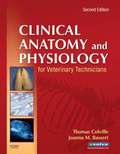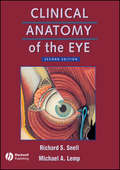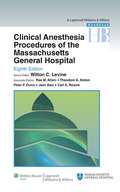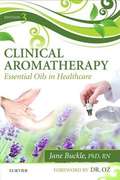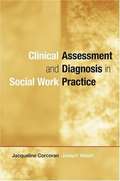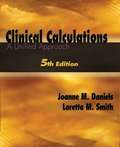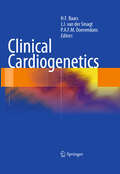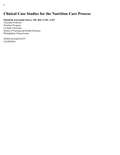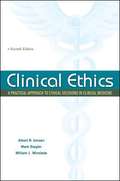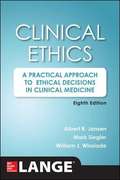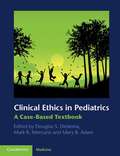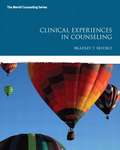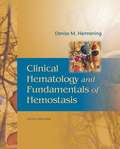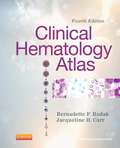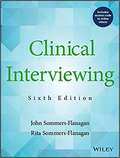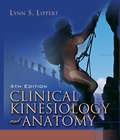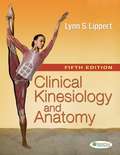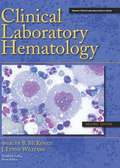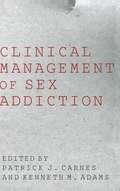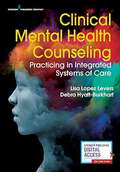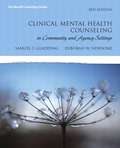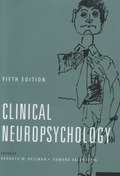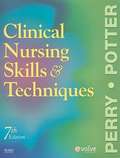- Table View
- List View
Clinical Anatomy and Physiology for Veterinary Technicians (2nd Edition)
by Joanna M. Bassert Thomas ColvilleExamine the diverse ways animal bodies function at both the systemic and cellular levels with this vital resource. It brings you clear coverage essential to understanding the clinical relevance of anatomical and physiological principles. Fully updated and written by respected veterinary technician educators, this popular textbook is the practical, comprehensive foundation for your success in veterinary technology. Clinical application boxes help you sharpen your skills and apply principles to practice. Test Yourself boxes throughout chapters emphasize important study points. An extensive glossary provides quick reference to hundreds of important terms and definitions. Over 300 new illustrations help you identify structures with rich, realistic clarity. A NEW full color format visually enhances your understanding of anatomic and physiologic concepts. Four NEW chapters give you the latest insight on the chemical basis of life, nutrition and metabolism, pregnancy, development, and lactation, and reptile and amphibian anatomy and physiology. A revised chapter on the cardiovascular system helps you most effectively comprehend the complex functions of the heart and blood vessels.
Clinical Anatomy of the Eye (Second Edition)
by Richard S. Snell Michael A. LempClinical Anatomy of the Eye has proved to be a very popular textbook for ophthalmologists and optometrists in training all over the world. The objective of the book is to provide the reader with the basic knowledge of anatomy necessary to practice ophthalmology. It is recognised that this medical speciality requires a detailed knowledge of the eyeball and the surrounding structures. The specialist's knowledge should include not only gross anatomic features and their development, but also the microscopic anatomy of the eyeball and the ocular appendages. The nerve and blood supply to the orbit, the autonomic innervation of the orbital structures, the visual pathway, and associated visual reflexes should receive great emphasis. The practical application of anatomic facts to ophthalmology has been emphasised throughout this book in the form of Clinical Notes in each chapter. Clinical problems requiring anatomic knowledge for their solution are presented at the end of each chapter. Illustrations are kept simple and overview drawings of the distribution of the cranial and autonomic nerves have been included.
Clinical Anesthesia Procedures of the Massachusetts General Hospital (8th Edition)
by Wilton C. LevineThis manual continues to emphasize the clinical fundamentals involved in the safe administration of anesthesia, perioperative care, critical care, and pain management.
Clinical Aromatherapy: Essential Oils In Healthcare
by Jane BuckleEnhance patient care with the help of aromatherapy! Clinical Aromatherapy: Essential Oils in Healthcare is the first and only peer-reviewed clinical aromatherapy book in the world and features a foreword by Dr. Oz. Each chapter is written by a PhD nurse with post-doctoral training in research and then peer reviewed by named experts in their field. This clinical text is the must-have resource for learning how to effectively incorporate aromatherapy into clinical practice. This new third edition takes a holistic approach as it examines key facts and topical issues in aromatherapy practice and applies them within a variety of contexts and conditions. This edition also features updated information on aromatherapy treatments, aromatherapy organizations, essential oil providers, and more to ensure you are fully equipped to provide patients with the best complementary therapy available.
Clinical Assessment and Diagnosis in Social Work Practice
by Jacqueline Corcoran Joseph WalshThis tightly focused textbook will help clinical social workers not only develop competence in the Diagnostic and Statistical Manual (DSM-IV-TR) system of diagnosis, it will also assist them to stay attuned during client assessment to social work values and principles -- a focus on client strengths, concern for the worth and dignity of individuals, appreciation of environmental influences on behavior, and a reliance on evidence-based approaches.
Clinical Calculations: A Unified Approach (5th edition)
by Loretta M. Smith Joanne M. DanielsThe original is now a classic. Clinical Calculations was the first text to introduce the dimensional analysis method of calculating dosages, an approach rapidly becoming the method of choice for nurses. The fifth edition of this trailblazer showcases its proven strengths: a clear writing style, workbook-style format, strong IV therapy content, and clinical applicability. Critical thinking is encouraged in conjunction with memorized rules by asking learners to always consider whether their answers make sense. It does this within the context of providing the core knowledge-base for dosage calculation and administration for learners of all levels and experience. Chapters cover the range of practice, including systems of measurement, oral and parenteral medications, basic and advanced intravenous medications, and pediatric dosage. Just as the title suggests, this resource is the ideal tool for calculation in a clinical setting. With copious reference tools, outlined injection sites for IV therapy, and unique performance criteria for evaluating nurse competency, the tradition of excellence and innovation continues.
Clinical Cardiogenetics
by H. F. Baars J. J. van der Smagt P. DoevendansClinical management and signs are the focus of this practical cardiogenetic reference for those who are involved in the care for cardiac patients with a genetic disease. With detailed discussion of the basic science of cardiogenetics in order to assist in the clinical understanding of the topic. The genetic causes of various cardiovascular diseases are explained in a concise clinical way that reinforces the current management doctrine in a practical manner. The authors will cover the principles of molecular genetics in general but also specific to cardiac diseases. They will discuss the etiology, pathogenesis, pathophysiology, clinical presentation, clinical diagnosis, molecular diagnosis and treatment of each cardiogenetic disease separately. Therapy advice, ICD indications, indications for and manner of further family investigation will all be covered, while each chapter will also contain take-home messages to reinforce the key points. The chapters reviewing the different diseases will each contain a table describing the genes involved in each. Each chapter will also contain specific illustrations, cumulatively giving a complete, practical review of each cardiogenetic disease separately. Special emphasis will be given to advice on how to diagnose and manage cardiogenetic diseases in clinical practice, which genes should be investigated and why, and the pros and cons of genetic testing. Guidelines for investigation in families with sudden cardiac death at young age will also be included. This book will be written for the general cardiologist and the clinical geneticist who is involved in cardiac patients and will provide answers to question such as: Which genes are involved and which mutations? What is the effect of the mutation at cellular level? Which genes should be tested and why? What is the value of a molecular diagnosis? Does it influence therapy? When should the first degree relatives be tested and in which way?
Clinical Case Studies for the Nutrition Care Process
by Elizabeth Zorzanello EmeryDesigned for graduate nutrition students, dietetic interns, and practicing dietitians, Clinical Case Studies for the Nutrition Care Process presents realistic scenarios for a variety of cases organized in the format of the Nutrition Care Process. Cases are drawn from the author’s experience and collected from practitioners who are experts in their field, providing a variety of interesting scenarios. Topics such as adolescent obesity and dietary management in diabetes are explored. <p><p> As a part of the American Dietetic Association’s Nutrition Care Process (NCP), dietitians, educators, and students have been asked to adopt a new standardized language for nutrition diagnosis. While this process utilizes many aspects of the traditional care model, dietitians may be unsure of how to implement the completely new aspect of standardized language and Nutrition Diagnosis. <p><p> Not only does this book include an introductory section on the Nutrition Care Process, but readers will learn how to use the standardized terms, develop a nutrition diagnosis, and apply the standardized language to specific clinical cases.
Clinical Ethics: A Practical Approach to Ethical Decisions in Clinical Medicine (Seventh Edition)
by Albert R. Jonsen Mark Siegler William J. WinsladeThis book is about the ethical issues that clinicians encounter in caring for patients such as informed consent, truth telling, confidentiality, privacy, the distinction between research and clinical care, and end-of-life care.
Clinical Ethics: A Practical Approach to Ethical Decisions in Clinical Medicine
by Albert R. Jonsen Mark Siegler William J. WinsladeTrust the proven "Four Box" method to formulate ethically appropriate recommendations for patient care. Clinical Ethics teaches healthcare providers how to effectively identify, evaluate, and resolve ethical issues in clinical medicine. Using the author acclaimed "Four Box Method" and numerous illustrative case examples, this book enables practitioners to gain a better understanding of the complexities involved in ethical cases and demonstrates how to reach resolution to ethical problems. Clinical Ethics goes beyond theory to offer a decision-making strategy applicable to real-world practice. Readers will learn an easy-to-apply system based on simple questions about medical indications, patient preferences, quality of life, and contextual features that clearly explain clinical ethics and help them formulate a sound diagnosis and treatment strategy. The case examples have been selected to demonstrate how principles apply to real-world everyday practice. The co-authors, a bioethicist, a physician and a lawyer/ psychoanalyst /philosopher, draw on more than forty years respectively of clinical experience to select exemplary cases of ethical problems and to reflect on how moral principles and concepts can guide clinicians in formulating ethically appropriate recommendations for patient care. A unique chapter organization: Each chapter of the book begins with some general considerations about the topic, and the ethical principle relevant to that topic. The clinical situations that generate ethical problems are then described and illustrated by clinically realistic medical cases. A short distillation of current opinion from the bioethical literature is provided, followed by an analysis of the cases. . The authors conclude with recommendations that the three authors have formulated from their extensive experience as bioethics consultants.
Clinical Ethics in Pediatrics: A Case-based Textbook
by Douglas S. Diekema Mark R. Mercurio Mary B. AdamThis volume provides a practical overview of the ethical issues arising in pediatric practice. The case-based approach grounds the bioethical concepts in real-life situations, covering a broad range of important and controversial topics, including informed consent, confidentiality, truthfulness and fidelity, ethical issues relating to perinatology and neonatology, end-of-life issues, new technologies, and problems of justice and public health in pediatrics. A dedicated section also addresses the topics of professionalism, including boundary issues, conflicts of interests and relationships with industry, ethical issues arising during training, and dealing with the impaired or unethical colleague. Each chapter contains a summary of the key issues covered and recommendations for approaching similar situations in other contexts. Clinical Ethics in Pediatrics: A Case-Based Textbook is an essential resource for all physicians who care for children, as well as medical educators, residents and scholars in clinical bioethics.
Clinical Experiences In Counseling
by Bradley T. ErfordClinical Experiences in Counseling gives interns and practicum students the practical, nitty-gritty information and skills they need to successfully complete their clinical experiences, and proudly join the counseling profession with confidence. Packed with case examples, self-assessments, activities, and “voices from the field,” it bridges the gap between theory and practice at the most critical juncture of their training—practicum and internship. Included is ready-to-use information on such critical topics as integrating theory and practice, building relationship, setting goals, record keeping, expectations and getting the most out of the supervision process, assessment and intervention, wellness and developing healthy work and personal habits, applying law and ethics in everyday practice, working with special issues and populations, self assessment, and more.
Clinical Handbook of Psychological Disorders: A Step-by-Step Treatment Manual (Third Edition)
by David H. BarlowWritten primarily from a cognitive-behavioral perspective, this book describes treatment methods for various disorders.
Clinical Hematology And Fundamentals Of Hemostasis
by Denise M. HarmeningComplete coverage of red blood cells, white blood cells, hemostasis, and thrombosis. <p><p> Chapters on flow cytometry and molecular diagnosis. <p> Thorough discussion of anemias. <p> Case histories demonstrate the link between the test and the patient to foster critical thinking. <p> Laboratory methods section includes chapters on routine hematology methods, automated differential analysis, cytochemistry, and more. <p> More than 900 illustrations, including 309 full-color microphotographs. <p> Chapter Outline and Educational Objectives at the beginning of each chapter <p> Study Questions and answers for each chapter. <p> Table of normal hematologic values on the inside covers <p> Glossary for easy access to definitions for medical terms unique to hematology and hemostasis. <p> Summary charts provide quick review, enhancing readability
Clinical Hematology Atlas (Fourth Edition)
by Bernadette F. Rodak Jacqueline H. CarrAn excellent companion to Rodak's Hematology: Clinical Principles & Applications, this atlas is ideal for helping you accurately identify cells at the microscope. It offers complete coverage of the basics of hematologic morphology, including examination of the peripheral blood smear, basic maturation of the blood cell lines, and discussions of a variety of clinical disorders. Over 400 photomicrographs, schematic diagrams, and electron micrographs visually clarify hematology from normal cell maturation to the development of various pathologies. Normal Newborn Peripheral Blood Morphology chapter covers the unique normal cells found in neonatal blood. A variety of high-quality schematic diagrams, photomicrographs, and electron micrographs visually reinforce your understanding of hematologic cellular morphology. Spiral binding and compact size make this book easy to use in a laboratory setting. Coverage of common cytochemical stains, along with a summary chart for interpretation, aids in classifying malignant and benign leukoproliferative disorders. Morphologic abnormalities are presented in chapters on erythrocytes and leukocytes, along with a schematic description of each cell, to provide correlations to various disease states. Body Fluids chapter covers the other fluids found in the body besides blood, using images from cytocentrifuged specimens. Updated information on the subtypes of chronic lymphocytic leukemia (CLL) helps you recognize variant forms of CLL you may encounter in the lab.
Clinical Interviewing
by John Sommers-Flanagan Rita Sommers-FlanaganClinical Interviewing is the essential guide to conducting initial interviews, suicide assessment, mental status examinations, and psychotherapy skill development. The Sixth Edition includes: Updates focusing on latest trends in clinical interviewing research and practice Updated information on technology-based interviewing Access to over 70 videos that show the authors discussing and demonstrating crucial interviewing techniques Online instructor’s manual and resources to facilitate teaching Fresh case examples to help apply interviewing skills and concepts New coverage of special populations and multicultural considerations Expanded skills coverage to help facilitate client insight and action This new edition also includes a Registration Access Card with a unique one-time code to access the Wiley Interactive E-Text (Powered by VitalSource), enhanced with dynamic content, including instructional videos and practice questions to further enrich student learning. It provides uninterrupted, mobile access anywhere, anytime. <P><P><i>Advisory: Bookshare has learned that this book offers only partial accessibility. We have kept it in the collection because it is useful for some of our members. Benetech is actively working on projects to improve accessibility issues such as these.</i>
Clinical Kinesiology and Anatomy (4th edition)
by Lynn S. LippertLynn Lippert adds a greater emphasis on clinical insights and functional connections to her easy-to-understand, well-organized 4th edition text. This accurate and thoughtfully updated edition is what should be at the heart of the clinical kinesiology course to help students analyze the mobility of specific joints in various activities of daily living. The first seven chapters describe the various body systems, terminology, and biomechanical principles that will be applied in the individual joint chapters that follow.
Clinical Kinesiology and Anatomy (Fifth Edition)
by Lynn S. LippertThis book provides fundamental understanding of Kinesiology and anatomy from a clinical perspective.The anatomical basis of common pathological conditions is briefly described in most chapters to give greater clinical relevance.
Clinical Laboratory Hematology (Second Edition)
by Shirlyn B. MckenzieDesigned to meet the needs of both clinical laboratory technicians and clinical laboratory scientists, CLINICAL LABORATORY HEMATOLOGY has been updated into a brand new edition. This comprehensive--yet easy to read--guide to hematology and hemostasis features cutting-edge technologies, high-quality photographs and micrographs, case studies, and convenient dual-level (basic and advanced) presentation of information. Visual cross-referencing (symbols) throughout make finding information exceptionally easy. Key chapters are presented by a number of different authors and experts in the field and include information on: cellular homeostasis; the Stucture and Function of Hematopoietic Organs; Hemolytic anemia; Nonmalignant lymphocyte disorders and much more.
Clinical Legal Education: A Textbook for Law School Clinical Programs
by David A. ChavkinThis textbook was created to provide a new tool for clinical teachers. It links together the central lawyering skills and values that are part of any clinical experience. Clinical Legal Education was written with a concentration on the Theory of the Client - a broadening of "case theory" to encompass all of the legal and non-legal approaches that can be used to advance one or more of a client's goals. Rather than defining prescriptive approaches to lawyering tasks, each chapter explores a number of "choice moments," those points at which a lawyer's choices will affect the scope and nature of the representation. Clinical Legal Education will help students learn to identify those moments and to effectively reach and implement decisions with their clients.
Clinical Management of Sex Addiction
by Patrick J. Carnes Kenneth M. AdamsThis is the first comprehensive volume of the clinical management of sex addiction. Collecting the work of 28 leaders in this emerging field, the editors provide a long-needed primary text about how to approach treatment with these challenging patients. The book serves as an excellent introduction for professionals new to the field as well as serving as a useful reference tool. The contributors are literally the pioneers of one of the last frontiers of addiction medicine and sex therapy. With a growing awareness of sex addiction as a problem, plus the advent of cybersex compulsion, professional clinicians are being confronted with sexual compulsion with little clinical or academic preparation. This is the first book distilling the experience of the leaders in this emerging field. With a focus on special populations, it also becomes a handy problem-solving tool. Readable, concise, and filled with useful interventions, it is a key text for a problem clinicians must be able to identify. It is destined to be a classic reference.
Clinical Mental Health Counseling: Practicing in Integrated Systems of Care
by Lisa Lopez Levers Debra Hyatt-BurkhartThis introductory textbook, written specifically for graduate students in clinical mental health counseling programs, is distinguished by a unique integrated system-of-care approach, reflecting current trends in mental health treatment. Designed to address the 2016 CACREP standards, the book delivers an in-depth examination of the professional knowledge, skills, and current issues in professional counseling that are essential to clinical practice. The textbook emphasizes the elements of practice, while providing students with ample case studies that enable them to integrate theoretical concepts with real-world examples. By distilling a wealth of knowledge from experts in the field, the textbook looks at the history and contemporary issues of mental health counseling through the lens of a bioecological approach. Engaging chapters focus on issues critical to mental health counseling, including strength-based approaches, varied clinical practice settings, professional issues, self-care, and more. Additionally, the text presents dilemmas and pitfalls intrinsic to mental health practice. Learning objectives, case illustrations, and abundant resources in each chapter reinforce the practical, real-world information upon which students can build throughout their education. A robust Instructor’s Manual and key PowerPoint slides also are provided. Purchase includes access to the e-book for use on most mobile devices or computers. Key Features: Offers unique, integrated system-of-care and community-based approaches integral to current trends Provides emphases on strength-based and ecological perspectives of CMHC practice Includes real-life examples and insights that facilitate the integration of theory and practice Describes dilemmas and pitfalls intrinsic to a variety of mental health practice topics Includes tips from the field and real-world case illustrations to enhance clinical application Includes learning objectives in each chapter Reflects 2016 and 2009 CACREP standards that are highlighted in each chapter
Clinical Mental Health Counseling in Community and Agency Settings (Third Edition)
by Samuel T. Gladding Deborah W. NewsomeWith expanded content and an emphasis on Council for Accreditation of Counseling and Related Programs (CACREP) standards, this user-friendly yet scholarly text again provides comprehensive coverage of all aspects of community counseling. Examines the many roles and functions community counselors perform, the variety of settings in which their work is done, and how that work differs from one client population to another. Emerging issues and trends in the field are given appropriate attention. First-person narratives throughout the text explore specific challenges and opportunities associated with particular areas of expertise.
Clinical Neuropsychology, Fifth Edition
by Kenneth M. Heilman Edward ValensteinNow in its Fifth Edition, Clinical Neuropsychology reviews the major neurobehavioral disorders associated with brain dysfunction and injury. Like previous editions of this book, the Fifth Edition focuses on the clinical presentation of the major neurobehavioral syndromes, including symptoms, signs, and methods of assessment that are useful for diagnosis, and also their underlying anatomy, physiology, and pathology. The major behavioral disorders that are covered include aphasia, agraphia, alexia, amnesia, apraxia, neglect, executive disorders and dementia. The text also discusses advances in assessment, diagnosis and treatment of these disorders. <p><p> The authors attempt to explain the cognitive mechanisms that can account for specific symptoms and signs, and to provide new information about treatment and management. The authors have drawn from a wealth of new information and research that has emerged since the Fourth Edition was published in 2003. The editors have added a chapter on creativity to the Fifth Edition, since there has been increased interest in creativity, and brain disorders can either enhance or impair creativity. <p> This text will be of value to clinicians, investigators, and students from a variety of disciplines, including neurology, psychology, cognitive neuroscience, psychiatry, and speech pathology.
Clinical Nursing Skills And Techniques (Seventh Edition)
by Anne Griffin Perry Patricia A. PotterWritten by the author team you trust, this market-leading text is known for its comprehensive coverage of over 200 nursing skills. It offers hundreds of full-color illustrations, a nursing process framework, and clear step-by-step instructions - with rationales for each step. Improved readability makes guidelines easier to follow, and coverage of many new skills keeps you completely current with nursing practice today. This market-leading book is written by the most respected team of authors and contributors in the profession. Comprehensive coverage includes over 200 basic, intermediate, and advanced nursing skills. Over 1,200 vivid, full-color photographs and drawings aid understanding. Five-step nursing process provides a framework for description of skills, as related to overall client care. Rationales for each skill step explain why steps are performed in a specific way, including their clinical significance and benefit, and incorporate the latest research findings. Unique! Critical decision points address key safety issues or possible skill modifications for specific patient needs. Unique! Unexpected outcomes and related interventions alert you to what might go wrong and how to appropriately intervene. Delegation principles discuss your responsibilities when assigning tasks to unlicensed assistive personnel. Guidelines for reporting and recording list what to document and include examples of proper wording. Cultural Considerations sections alert you to the care issues unique to people of specific cultural or ethnic backgrounds. Special considerations discuss variations in the needs of children, older adults, and home care patients, and help you provide appropriate patient education as mandated by the Joint Commission. Pediatric, geriatric, home care, and teaching considerations address specific patient needs. Critical thinking exercises challenge you to integrate information on patient assessment and care. . Over 250 new photos illustrate the most current equipment and techniques. . Improved readability includes a streamlined presentation, with material that's easier to comprehend. . Skills performance guidelines include key principles that apply to all skills covered within a chapter. . New Using Evidence in Nursing Practice chapter discusses the complete process of conducting research, collecting, critiquing, evaluating, and applying evidence to improve patient care. . A companion Evolve website includes additional review questions, an audio glossary and access to Evolve Mobile, where you can download the skills checklists and video clips for your iPod or MP3 player.
